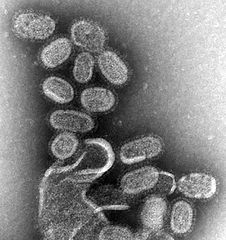Type a search term to find related articles by LIMS subject matter experts gathered from the most trusted and dynamic collaboration tools in the laboratory informatics industry.
| Influenza | |
|---|---|
| Classification and external resources | |
 Influenza virus, magnified approximately 100,000 times | |
| ICD-10 | J10., J11. |
| ICD-9 | 487 |
| DiseasesDB | 6791 |
| MedlinePlus | 000080 |
| eMedicine | med/1170 ped/3006 |
| MeSH | D007251 |
Influenza, better known as the flu and sometimes called the grippe, is a common childhood illness, but is not as common among adults. It is not limited to humans, most mammals and many birds can also catch influenza. It is caused by several different viruses, termed influenza viruses A, B, C, and D.
Human influenza can pass from one person to another very easily. It is most commonly spread by the microscopic droplets of mucus and fluid that are sent into the air when the sick person coughs or sneezes. Symptoms include cough, sore throat, muscle aches and pains, fever, headache, and rarely vomiting and diarrhea. Influenza can also lead to other diseases, such as pneumonia. This makes it especially dangerous to young children and elderly people.
Although there is no cure for influenza, antiviral drugs can be used to treat the illness so it is not as severe and does not last as long. Influenza vaccines are available worldwide, and are quite effective. They are changed each year as the virus changes.
The influenza season runs from late fall to spring because most people catch it in the winter months. When there are more cases of influenza than expected, it will sometimes be called an epidemic. When there are a large number of cases of the same type of influenza all over the world, it is often called a pandemic.
The virus is ancient. It has infected humans for centuries.[1]
Small changes that happen as flu is passed from one person to another is the most common way flu viruses change. This is the main reason that people can catch the flu every year.
The CDC keeps track of the different flu viruses that are circulating, and gives this information to the companies that make flu "shots". Since the flu changes so much from year to year, flu shots have to be given each new flu season.
Flu shots only protect against the most common flu viruses, and every now and then a slightly different type spreads more than expected. Usually when this happens, the existing flu shot gives some protection so that even if a person who had a flu shot catches it, they do not get as sick.
Some flu viruses are caught from animals. Bird flu, for example, is usually only caught by people in contact with sick birds (usually chickens). These types of flu virus are usually very limited, and while they can make a person very ill, usually other people do not catch the virus from the sick person.
Another way that the flu can change is when a person or animal catches two different flu viruses. The two viruses can exchange some of their genetic information, which can create a brand new flu that nobody has ever caught before.
If an animal flu virus changes in this way to one that can easily pass from human to human, many people become ill because nobody has any immunity to the new virus. Often, a brand new virus is more severe and kills more people.
New types of flu virus are usually what causes pandemics, and that is the reason many scientists have been following bird flu so closely—it kills six people out of every ten who catch it. This would be a very serious problem if it changes enough to spread easily between people.
This new flu virus got its name because it contains genetic parts that are commonly found in flu viruses that infect pigs.[2] It is not spread by pigs or by eating pork—this is a new human virus being spread by humans. The name was the 2009 flu pandemic.